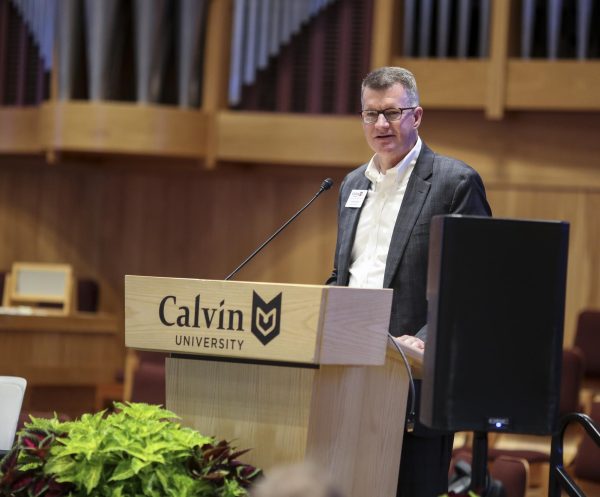History, faith and gender collide in controversy around article on sex, salvation
What does sex have to do with the church? When it comes to religious metaphors, how far is too far? How does power, especially gendered power, shape interpretation of Biblical ideas today?
When The Gospel Coalition — a group of Reformed and evangelical churches, founded by pastor Tim Keller and theologian D.A. Carson — published an article entitled “Sex Won’t Save You (But It Points to the One Who Will)” early this month, it quickly generated a firestorm of controversy, sparking debates on social media and within congregations. At heart, these debates centered on the questions above.
Chimes talked to campus experts on the politics of sex, religion and power to understand the history of the debate and conflict of values underpinning it today.
In the piece, Arizona pastor Josh Butler –– who would soon be publishing a book on the topic –– drew a detailed comparison between sex and salvation, declaring sex to be “an icon of Christ and the church.” In the very act of sex, he argued, the man represents Christ, while the woman represents the church. “Christ penetrates his church with the generative seed of his word and the life-giving presence of his Spirit, which takes root within her and grows to bring new life into the world,” the article read. “[The church] receives his generous gift within her.”
The piece sparked significant criticism online from several parties. For instance, in a March 1 Tweet, Christian author Jennifer Greenberg described it as “unacceptable,” “degrading to Jesus Christ” and “sex cult heresy.” In response to criticism, the article was ultimately pulled by The Gospel Coalition. (Its original text can now be found at The Wayback Machine, a digital archive.)
“Analogies can be illuminating to a point, but this one was taken a kabillion miles down the road from where it needed to be,” said University Pastor Mary Hulst. She described it as “a problematic way to think about our sexuality and our relationship with God.”
For Hulst, a more apt analogy for God and the church is marriage. Marriage is “about union and celebration,” Hulst told Chimes. “A part of marriage is sex, but anyone who’s married will tell you that’s a very small part of marriage. The idea of a feast and a celebration and this thing you’ve been longing for finally coming to fruition is really what the analogy is about.”
A major critique hinged on the article’s portrayal of men and women. “The article presents a very gendered description of sex, in which it would be easy for people to understand the male role as God’s role and the female role as the human’s role,” Hulst said.
“The theological assertions there, particularly around a husband essentially acting in the role of savior to his wife, raised some theological eyebrows,” said Kristin Du Mez, professor of history and gender studies. Du Mez was an active participant in the conversation as it was unfolding. “And equating the Holy Spirit essentially with a man’s semen seemed to be, in some people’s opinion, blasphemous.”
A historic debate rolls on
Linda Naranjo-Huebl, professor of English and gender studies, told Chimes that such discourse has a long history. “When I read [the article], the first thing I thought was, ‘This isn’t new,’” she said. “In the eighteenth and nineteenth century, what we read is that women, in the sex act, are passive receptacles. I thought I stopped hearing that kind of discourse a long time ago.”
But Naranjo-Huebl saw similar ideas in Butler’s article. She thought it presented women as “lacking agency” and “submissive.”
Both Du Mez and Naranjo-Huebl told Chimes that the way the metaphor was used in Butler’s piece could be extended to justify sexual abuse.
“A number of sexual abuse survivors pointed to the fact that these teachings are often used to essentially trap women in abusive relationships,” Du Mez said. “If [sex with their husband] is the mechanism of their salvation, it becomes really hard to resist abuse.”
Naranjo-Huebl also noted that the article’s premise could be “hurtful” to readers who don’t fit the prescribed relationship system well. “This can be particularly scary to those who don’t identify as heterosexual, perhaps identify as asexual, or perhaps are just worried about if they’ll ever meet the right person,” she said. “[The article] implies that they are missing a deep spiritual truth, that they can’t understand because they don’t have a heterosexual relationship.” But Naranjo-Huebl pointed out that Jesus did not have a sexual relationship, and the apostle Paul in the Bible wrote to the young church that celibacy was preferable to marriage.
Underlying values
According to Du Mez, the article was not an isolated occurrence: Similar beliefs are widespread in certain Christian circles. “It wasn’t just one guy,” she said. “It was a book that’s being published by a leading evangelical publisher [Multnomah], and then it was excerpted and platformed by The Gospel Coalition.”
Du Mez told Chimes that people of all different theological backgrounds had spoken out against the piece, but Butler’s ideas fit best into a framework of complementarianism, which emphasizes distinct gender roles. “Complementarianism is a way of interpreting the Bible to support patriarchal authority as really essential to God’s order for society,” Du Mez said. This concept could be defined in contrast to egalitarianism. According to Du Mez, egalitarianism reads the Bible in a way that is not “hierarchical” but is instead concerned with “mutuality.”
The Christian Reformed Church is not officially aligned with either stance, according to Du Mez. “The stance is that they’re open to churches that promote female leadership and ones that do not,” she said. “However, I will say that many people in the CRC . . . have been deeply influenced by complementarian pastors and writers.” Writers like John Piper and Wayne Grudem have been influential within the denomination, according to Du Mez.
Naranjo-Huebl saw connections between Butler’s article and the CRC’s Human Sexuality Report, the argument of which, she said, is “based on anatomy” and ultimately tied to procreation. “It’s consistent with much of the message there,” she said.
According to Du Mez, conversations like the one surrounding Butler’s article are more important than they seem. “It can seem like a kind of distant set of arguments, but I would say that there are deeper underlying values here,” she said. “What is it to be a man? What is it to be a woman? What is the role of hierarchy and power in our understanding of Christianity?”











Tom Eggebeen • Mar 29, 2023 at 8:37 am
Excellent essay – my thanks! Keep up the good work … none of it’s easy, but all of it counts. ~ the Rev. Dr. Tom Eggebeen (’66) … Pasadena, CA